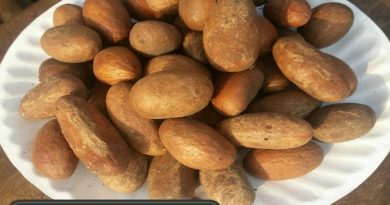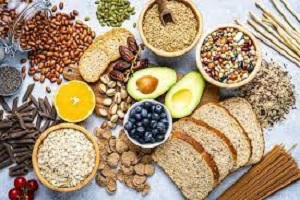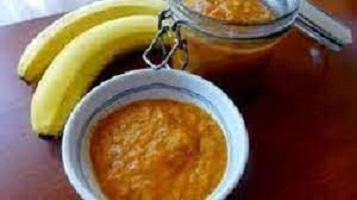Mediterranean Food: 40 Iconic Foods of Mediterranean
Mediterranean Food: 40 Iconic Foods of the Mediterranean
- Mediterranean Food: 40 Iconic Dishes You Should Try
- Best Mediterranean Foods You Need in Your Life
- Delicious Mediterranean Dishes To Try
- Iconic Mediterranean Foods to Try Before You Die
- Food of the Mediterranean
- Best Mediterranean Diet Foods for Heart Health
- Authentic Mediterranean Food Recipes
Mediterranean Food: 40 Iconic Dishes You Should Try
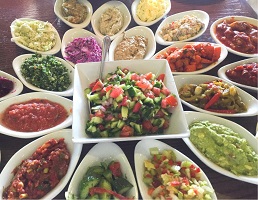
The Mediterranean’s perfect climate, combined with amazing wine and delicious foods, makes it completely irresistible.
Spain, France, Italy, Greece, Turkey, Syria, Israel, Egypt, Algeria, Libya, Tunisia, and Morocco are among the Mediterranean countries with a wide range of cuisines to sample.
We’re all aware that the Mediterranean is famous for its wine and seafood, but what exactly is Mediterranean cuisine?
Mediterranean food is home to some of the world’s most loved and iconic dishes. Many people believe that this diverse cuisine is the key to living a healthy life.
The geography, history, and recipes of Mediterranean food are also far more extensive than many people realize.
The Mediterranean diet is rich in flavorful ingredients like locally grown fruits, vegetables, whole grains, and heart-healthy fats, the Mediterranean diet is equally parts delicious and nutritious.
It’s also associated with a variety of benefits and may help support brain function, promote heart health, regulate blood sugar levels, and more.
Mediterranean food list
Although there are no concrete rules for how to follow the Mediterranean diet food list, there are many general guidelines you can follow to incorporate the principles of the diet into your daily routine.
Despite the fact that many dishes are plant-based, making it an excellent choice for vegetarians and vegans, meat, seafood, and dairy are frequently used in moderation.
This post will look at some of the common ingredients found in the Mediterranean diet as well as some of the region’s most famous dishes.
We start with some of the basics you’ll find everywhere, and then recommend some salads, soups, main courses, and desserts to try.
So, if you’re looking for new, fresh, and nutritious meals to try, we hope our selections will inspire you to try something new.
These come from a variety of Mediterranean countries.
What is Mediterranean food?
Simply put, Mediterranean food is derived from the countries and regions that surround the Mediterranean Sea.
Today, 23 countries are classified as Mediterranean. All of them bring a distinct set of flavors and techniques to Mediterranean cooking.
Where can I find Mediterranean food?
Mediterranean cuisine can be divided into three culinary regions. They are as follows:
- Eastern Mediterranean
- Southern Europe
- North Africa
Naturally, all three have a strong influence on one another. However, due to climate and cultural differences, each region has developed similar yet distinct cuisines.
Balkan, Greek, Turkish, Syrian, Lebanese, Israeli, Palestine, and Egyptian cuisines dominate Eastern Mediterranean cuisine.
Southern European cuisine includes Italian, Spanish, Portuguese, and Southern French dishes.
Moroccan, Algerian, Tunisian, and Libyan cuisines have a North African influence on Mediterranean food across the sea
5 Common Mediterranean Foods
- Olive Oil
- Pasta & Bread. Cereals and grains are the major sources of carbohydrates in a traditional Mediterranean diet, however, there are a huge range and variety of ways in which Mediterranean foods use crops like wheat – such as turning it into pasta.
- Fish
- Meat
- Cheese
Important Mediterranean Food Ingredients
Fresh vegetables, tender meats, and a variety of flavors characterize Mediterranean food.
Experts, on the other hand, have defined the core ingredients on which all regions have essentially built their cuisines olives, wheat, and grapes.
- Olives
Olive Oil – Everywhere
Of course, olive oil is the foundation of most Mediterranean cuisine. Olives are thought to have been used for 6,000-8,000 years.
The Persian region has grown olives for thousands of years. Today, 95% of the world’s olives are produced in the Mediterranean region.
As a result, olive oil has come to be associated with Mediterranean cooking and is the preferred cooking agent over butter, fats, and other oils.
- Seafood is available everywhere.
The Mediterranean’s abundant seafood is harvested and prepared according to local taste, and served bursting with beautiful flavors and textures.
You’ll be spoiled for choice with lobster, abalone, shrimp, octopus, squid, prawns, sea urchin, and more readily available.
- Fish – Everywhere
As each country borders the sea, it’s no surprise that fresh fish is perhaps more prevalent in Mediterranean dishes than meat. It’s a nutritious and delicious staple whether grilled, fried, or stewed in a rich vegetable sauce.
- Lamb from the Eastern Mediterranean
Although beef, pork, and veal dishes are popular in Spain, France, and Italy, lamb is the meat most commonly found in North African and Eastern European Mediterranean.
- Wine can be found everywhere.
The region has been producing wine for at least 6,000 years. Given the ideal climate, grapevines are grown in almost every Mediterranean country, and wine drinking is an essential part of any meal and a daily pleasure.
In addition, every area believes its wine is the best
- Wheat
Wheat cultivation has been documented in the Eastern Mediterranean region for nearly 10,000 years.
This is why bread is such an important part of Mediterranean cuisine, and how it influenced the development of other wheat-based foods like Italian pasta.
- Grapes
Finally, grapes are the reason wine is popular in many Mediterranean countries.
The location of Persia near the Black Sea provided an ideal climate for grape cultivation. According to evidence, grapes have been grown there for at least 8000 years.
However, the Italians were the first to use grapes to make wine several centuries before Christ’s birth.
Today, almost all grapes are grown for wine. Furthermore, the Mediterranean region produces nearly 40% of the world’s wine.
Let’s dive into 40 of the Mediterranean’s most delectable foods now that we’ve got our bearings and some context.

- Pita
Pita is one of the world’s most well-known and loved bread, thanks to its puffy texture and soothing flavor.
This rounded flatbread made of wheat flour has been wrapping around Middle Eastern delicacies for millennia.
Pita evolved from some of the earliest recorded flatbreads approximately 15,000 years ago.
It comes from the Fertile Crescent, a region of the Middle East that stretches from northern Egypt to the Persian Gulf.
However, it was the Greeks who really put pita on the map. The term “pita” first appeared in English in the 1930s.
Pita gets its distinctive ‘puffed’ appearance from being baked at extremely high temperatures, up to 475°F. This turns the water in the dough into steam.
This enables it to be used as a tasty pocket for a variety of delectable foods.
Some cuisines, however, such as Greek cuisine, prefer the pocket-less pita. Lower temperatures are used to bake it, resulting in a flatter, rounder pita.
Pita is the ‘popular kid’ at the Mediterranean cuisine school. It goes well with a wide variety of foods.
Greeks enjoy dipping it in rich sauces such as hummus. Turkish people stuff it with tender meat for their favorite kebabs. Cypriots stuff theirs with soft halloumi.
It’s the ideal bread for a hearty breakfast of hummus, pickled vegetables, and falafel in Palestine.
Pita will almost certainly appear in a variety of exciting recipes wherever your Mediterranean adventure takes you. Bread for all seasons!

- Moussaka
Few Mediterranean foods soothe the stomach as well as a delicious moussaka, which is rich and infused with intense flavor.
During the 1920s, Greek cuisine popularized this baked eggplant and ground meat casserole.
However, its origins can be traced back to the Levant. Turkey, Lebanon, and Israel are among the countries in this region to the east of the Mediterranean Sea.
The juiciness of sauteed eggplant and ripe tomatoes is combined with minced lamb in the traditional recipe.
Nikolaos Tselementes, a French-trained Greek chef, is credited with making moussaka one of Greece’s most famous dishes.
His method of layering moussaka is still widely used today.
The bottom layer is typically made up of layered eggplant and plenty of olive oil.
The meat is in the middle layer, pairing minced lamb with a range of delicious vegetables and seasonings.
Finally, a layer of Béchamel, or white sauce, on top binds the entire moussaka together. Nikolaos Tselementes would prepare the three layers individually before baking them together.
Tselementes’ inclusion of the classic French Béchamel sauce was his attempt to rid the dish of Turkish influence while Greece was under Turkish rule.
Moussaka is popular in a variety of recipes throughout the Mediterranean. It’s a dish for any occasion, as it’s filling and flavorful.
Popular Mediterranean Salads
:max_bytes(150000):strip_icc()/Simply-Recipes-Nicoise-Salad-LEAD-10-142a737d4d3541f28c5bc330355b2f65.jpg)
- Niçoise Salad
This ideal summer salad conjures up images of lazy lunches in the chic restaurants of the French Riviera.
:max_bytes(150000):strip_icc()/__opt__aboutcom__coeus__resources__content_migration__simply_recipes__uploads__2011__08__dads-greek-salad-horiz-a-1600-bc71b85bc907414a9bb3179a923b58fc.jpg)
- Salad Greek
The Mediterranean climate allows for the cultivation of truly ripe and juicy vegetables and fruits.
Simply walking through a Greek, Turkish, or Italian food market will amaze you with the size and vibrant color of the fruits and vegetables.
In addition, in the sweltering heat, a cool and refreshing salad is often the order of the day.
A Greek salad is thought to have originated as a result of farmers in rural areas preparing a quick meal with what they had on hand.
The Greek salad is traditionally made with fresh tomatoes, cucumbers, bell peppers, and olives from the ground or markets.
Feta cheese is its distinguishing feature. A slice was traditionally used to coat the salad ingredients. Salads with cubed or crumbled feta are now available.
Drizzle the salad with olive oil and season it generously, and you have a delicious salad at the beating heart of Greek cuisine.

- Fattoush Salad
Our next stop is Lebanon, and a multi-layered salad that is central to Levantine cuisine: Fattoush salad.
The term ‘fattoush’ is derived from the Arabic word fatt, which means ‘to crush.’ Fattoush, like Greek salad, is an example of Mediterranean ingenuity.
It is believed that Lebanese farmers would gather any remaining scraps of pita bread.
They would then fry them in oil and toss them into a salad of vegetables they had on hand.
This recipe quickly became popular throughout the Levant. There are numerous variations throughout the region’s countries.
A traditional Fattoush salad today will include freshly chopped cucumbers, lettuce, tomatoes, onions, and radish.
A sprig of mint or a squeeze of lemon adds another layer to the warm dough and the crisp vegetables of the salad.
A true Mediterranean delight and one of the region’s most basic but diverse dishes.
:max_bytes(150000):strip_icc()/Simply-Recipes-Baklava-LEAD-4-a9d125c8d66547ef9f92c6564a5d5241.jpg)
- Baklava
Baklava is a multi-textured pastry dessert that originated in Turkey during the Ottoman Empire’s reign.
It sandwiched crushed nut beds between layers of filo pastry and glued them together with sweet honey syrup.
Baklava’s pastry layers are flakey and buttery. This crunch, combined with the honey’s thick, sweet texture, makes for an exquisite bite.
The most popular nuts in Turkey and Greece are pistachios and walnuts. However, many other crushed nuts have been used in recipes.
It’s a perfect slice of heaven to follow dinner on a warm Mediterranean evening when served chilled.
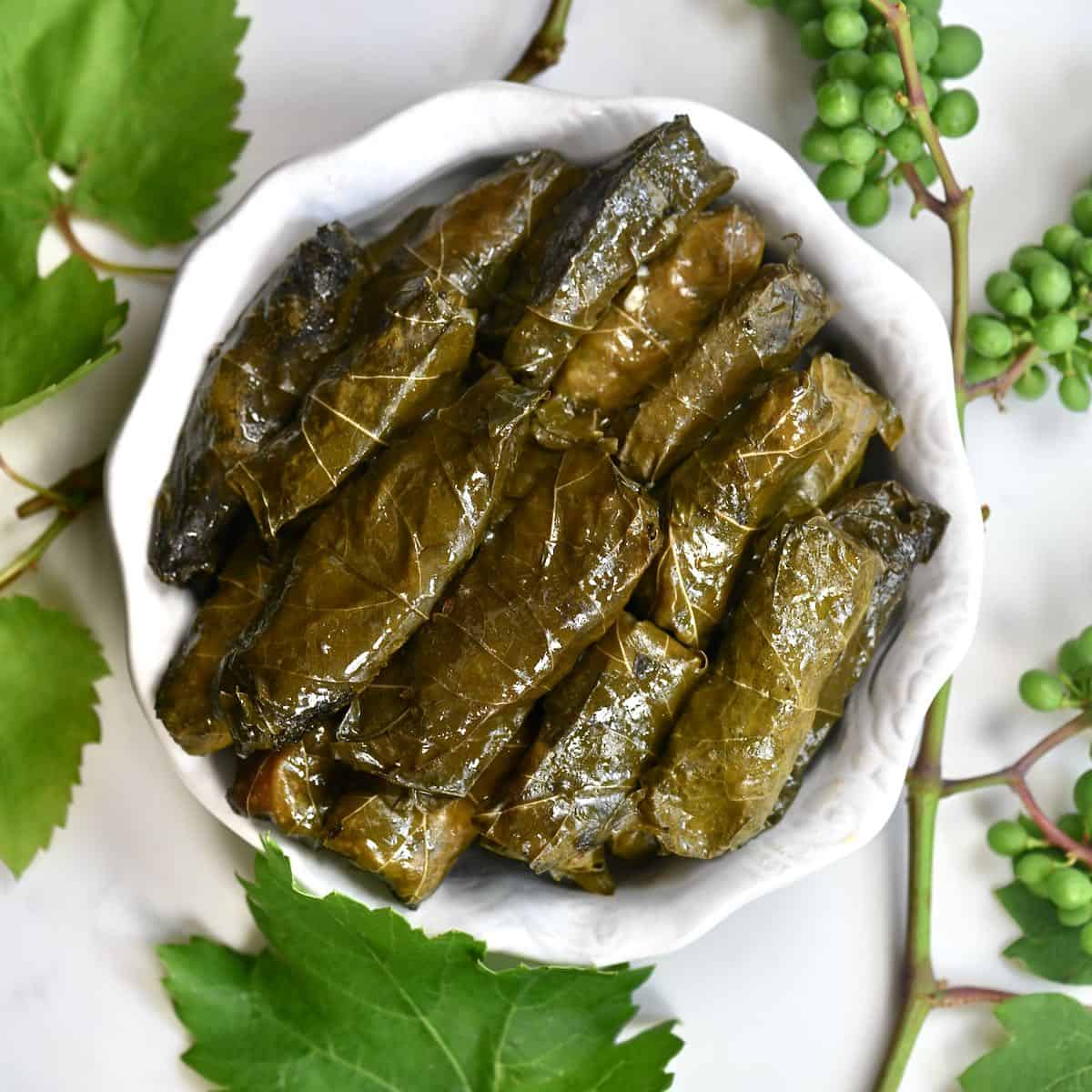
- Dolmas
Dolmas are an important Mediterranean food family. Stuffing vegetables with hearty foods have been done for centuries.
Dolmas are thought to have originated in the Middle East. Long before the Ottoman Empire, stuffed vegetable recipes were documented in Arabic cookbooks.
Dolmas are interpreted differently in the East Mediterranean and Middle East regions.
In Turkey, you can find vibrant, roasted eggplant stuffed with ground lamb and hearty rice, seasoned with spices, and topped with lemon.
Sogan dolmasi can be found in Bosnia and Herzegovina, in the Balkans.
In this recipe, peeled onions are stuffed with minced beef, rice, generous seasonings, and sour cream.
Balls of spiced and cinnamon-infused rice wrapped snuggly in vine leaves can be found in Syria, Iraq, and Armenia to the east.
Dolma is one of the most historically significant Mediterranean foods. It demonstrates how inventive and resourceful you can be with basic ingredients.

- Borek
Borek was a true Ottoman Empire favorite. Its name is thought to be derived from the Turkish word bur, which means “to twist.”
The twisting, spiral shape of this flavor-filled baked pastry is the first thing you’ll notice.
Borek is typically made from filo or yufka pastry. It’s baked in a large pan before being cut into slices.
Other parts of the Mediterranean bake it in individual, bite-sized pieces.
In terms of fillings, Mediterranean countries all have their own delicious take on this wonderful dish.
Su börei, a popular variation from Turkey, has a creamy mixture of feta cheese and parsley between layers of flaky pastry.
Thick cheeses, spinach, or ground beef are popular in Armenia. Greece has even created a citrus-flavored dessert borek.
Borek’s influence can be found as far south as the Balkans, as far north as North Africa, and as far west as Central Asia.
It is, without a doubt, a people’s Mediterranean cuisine.
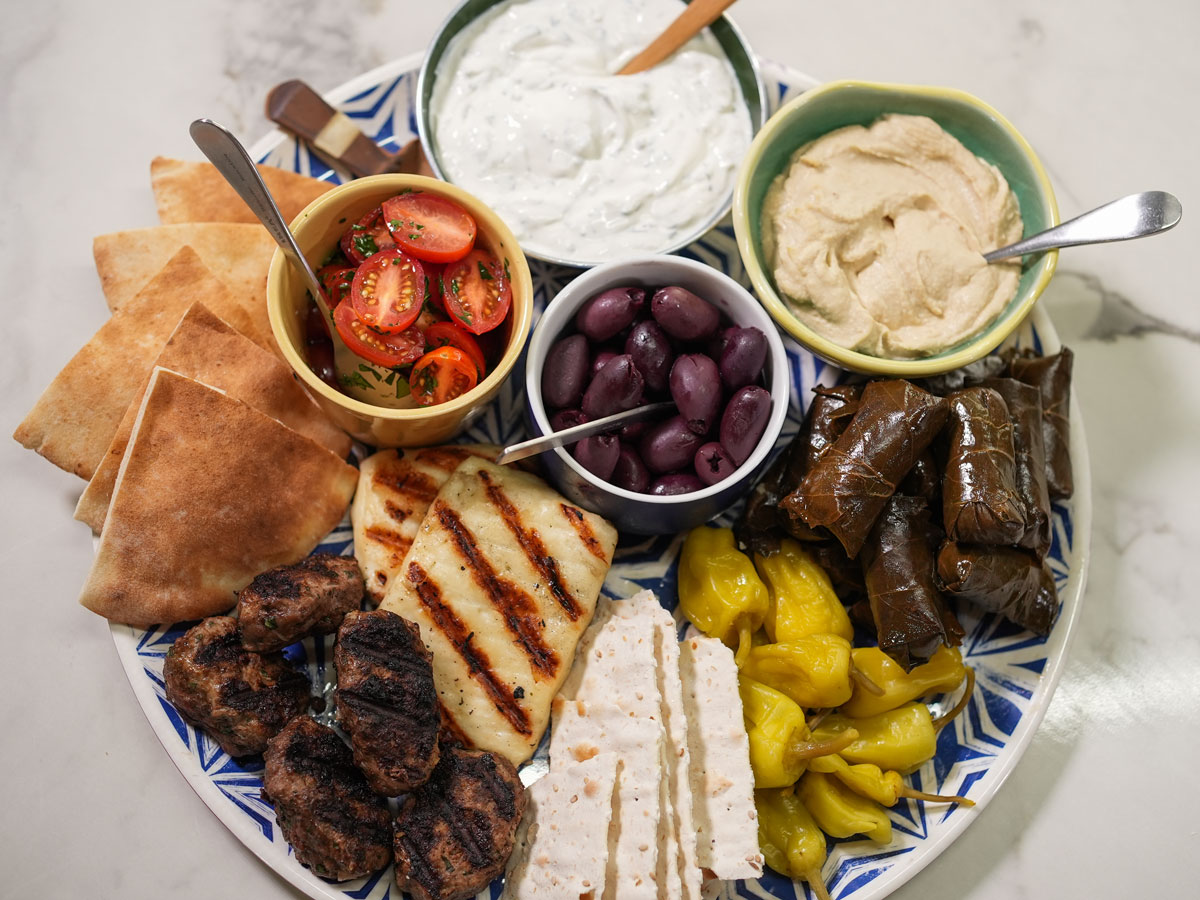
- Mezze
To this point, we’ve looked at some truly hearty foods. So let’s take a look at one of the most popular appetizers in Mediterranean cuisine.
Mezze is a Persian word that literally means “to taste.”
Mezze is not a food, but rather a collection of small dishes and appetizers that vary from country to country.
Turkish mezze encompasses a wide range of delectable flavors. Sliced melon, pepper and walnut sauce, and fried calamari are among the options.
Tabbouleh, hummus, and baba ghanoush are also popular mezze dishes.
These are just a few of the many foods available. Fava beans and grilled cheeses are popular mezze dishes in Greece and Cyprus.
Mezze serves two distinct functions depending on where you eat it.
In Turkey, Greece, and the Balkans, mezze is a popular appetizer served at social gatherings where alcohol is served.
A variety of alcoholic beverages, such as rakia and Cyprus brandy, complement the diverse flavors of mezze.
Mezze is eaten as a main course in Muslim Mediterranean regions where alcohol is not consumed.

- Falafel
It’s time to travel to North Africa and highlight one of the most well-known vegetarian dishes: falafel.
Falafel is a simple but tasty recipe. Each ball is made from mashed chickpeas and a variety of herbs and spices.
These bite-sized treats are formed into small patties. They are then deep-fried and served as an individual dish or as part of a larger meal or meze.
The history of falafel is hazy. They are thought to have originated in ancient Egypt as a simple snack to replace meat during fasting.
Originally, lava beans were used in falafel. However, as this food spread north into the Middle East, chickpeas quickly replaced lava beans.
In Mediterranean food, you’ll find them nestled in fresh salads, and pita sandwiches, and dipped in a range of tasty sauces, like tahini.

- Moroccan Tagine
Moroccan tagine is essentially a Mediterranean stew with a rich history and a wide range of varied recipes.
The term ‘tagine’, on the other hand, refers to the method of cooking, in a large and shallow pot over high heat, rather than the ingredients.
Tagine dates back to the 9th century when Arabic ruler Harun al-Rashid and his armies conquered much of North Africa and the Levant.
Moroccan tagine encompasses a wide range of recipes, both meat-based and vegetarian. Tagine’s allure stems from its sweet and savory fusions.
Moroccan tagine is brimming with spices. These recipes frequently include the flavors of cinnamon, saffron, and ginger, among others.

- Margherita Pizza
A pizza with mozzarella cheese, tomatoes, and basil was made in honor of Queen Margherita of Savoy. The official colors of the Italian flag are white, red, and green.
Pizza is a popular delicacy throughout Italy. Those who get the chance to eat a rustic, stone-baked pizza in Naples are in for a treat.
Margherita pizza incorporates several of the most well-known Mediterranean flavors.
This recipe has a wheat-bread base, juicy vegetables, creamy cheese, and a generous amount of olive oil.

- Spanakopita
The traditional Greek spinach pie with feta cheese, or spanakopita, is made with layers of crisp phyllo sheets filled with spinach and feta cheese.
The name Spanakopita is pronounced, “spah-Nah-KO-pee-tah.” It can be made as a “pita” or as a pie and cut into squares or individual phyllo triangles.

- Hummus
In terms of appetizers, hummus is another delicious and nutritious option for starting a meal in the Mediterranean region.
Hummus is a popular dish in this part of the world. It is made by combining chickpeas, sesame seeds, olive oil, lemon juice, and garlic.
One factor that contributes to the dish’s exceptionality is the fact that fresh bread, fruits, and vegetables are typically served alongside Mediterranean hummus.
When it comes to being so fresh, that sweetness is unrivaled.

- Dolmas
Dolmas are an important part of Mediterranean cuisine. Stuffing vegetables with concentrated ingredients is a centuries-old practice.
Dolmas are interpreted differently in different parts of the East Mediterranean and the Middle East.
In Turkey, stuffed eggplant with ground lamb and substantial rice spiced and drizzled with lemon juice.
This dish combines peeled onions, ground beef, rice, a variety of spices, and sour cream. One of the most historically significant Mediterranean foods is dolma. It demonstrates how inventive and creative one can be with basic ingredients.

- Ratatouille
Ratatouille, a stewed vegetable dish, is made with tomatoes, garlic, onions, zucchini, eggplant, bell peppers, marjoram, fennel, and basil.
Ratatouille from the film Ratatouille is coming to your table for Meatless Monday!
This vegetable casserole is a great way to start the week with a filling vegetarian meal that is low in calories.
It has layers of colorful fresh vegetables and a garlicky tomato sauce.

- Shawarma Chicken
After eating this oven-roasted chicken shawarma, you’ll feel like you’ve stepped onto a Middle Eastern street.
There’s a lot of flavors here. The key is a simple spice blend that can be made at home for shawarma.
This recipe includes detailed instructions as well as a video that will walk you through every step of making this delectable chicken dish.

- Tabouli
Without a doubt, tabouli is the epitome of a traditional Mediterranean salad (or tabbouleh). Bulgur wheat is mixed with finely chopped vegetables, fresh parsley, and a lot of bulgur wheat. Fresh lime juice and extra virgin olive oil are then added. They’ve discovered that adding cucumbers to my tabouli adds a satisfying crunch.

- Moussaka
Moussaka is one of the few Mediterranean dishes that can soothe an upset stomach like nothing else. In the traditional recipe, ground lamb is combined with sautéed eggplant and ripe tomatoes.
Nikolaos Tselementes, a French-trained chef, is credited with making moussaka one of Greece’s most well-known dishes. In most recipes, the bottom layer is stacked eggplant with lots of olive oil.
The center layer is made up of ground lamb, vegetables, and seasonings. A layer of Béchamel, a white sauce, completes the dish.
:max_bytes(150000):strip_icc()/__opt__aboutcom__coeus__resources__content_migration__serious_eats__seriouseats.com__recipes__images__2017__09__20170919-risotto-reshoot-vicky-wasik-2-b0920ac0d2db4b3e887235ae9ec07f7e.jpg)
- Risotto
Risotto is a traditional Italian dish made from rice and other nutritious ingredients. When served, this dish should be a soft, fluffy mound on a serving platter rather than runny or gluey.
Throughout the years, many risotto varieties have been developed and refined.
Butter, Parmesan cheese, and fresh parsley are used in this simple risotto recipe. This is an excellent recipe to use if this is your first time making risotto.
Risotto is a dish in which rice is cooked in broth with other ingredients like parmesan cheese, onions, wine, and butter
:max_bytes(150000):strip_icc()/84137-easy-paella-1x1-166-d61f301a4a0344c5b3f1e652a087df5a.jpg)
- Paella
Paella is traditionally made with saffron-infused white rice, vegetables, chicken, and seafood cooked in a single pan and served at the table.
Valencian paella is widely regarded as Spain’s national dish, though there are several other styles to choose from.
The most common types of paella are mixed or chicken paella (a combination of seafood, meats, and vegetables).
Stuffed flatbreads can be made with a variety of ingredients and are always a crowd-pleaser.
Because gozleme is a popular street food, you’ll always find gozleme vendors at markets and restaurants.
A glass of Tur

- Gozleme
kish tea, cay or our traditional yogurt drink goes perfectly with gozleme.

- Mediterranean Quinoa
This bowl contains either hummus or the Smokey red bell pepper sauce. The sauce is made with red bell pepper, almonds, and a variety of other ingredients. For added flavor, throw in your favorite vegetables.
When you love the flavors of the Mediterranean, it’s difficult to go wrong with this Quinoa Bowl with Mediterranean Flavors.

- Shakshouka
Shakshouka begins with a ripe, rich base sauce of juicy tomatoes, peppers, onions, and a generous drizzle of olive oil. Spices are widely used in North African cuisine.
The flavors of paprika, nutmeg, cumin, and pepper dominate the sauce.
Poached eggs are placed on top of this bubbling stew. Spices are used liberally to enhance the flavor of these eggs.
People in the Middle East have been eating tomato-based stews like these for hundreds of years.
There were many different types of shakshuka, particularly in the Ottoman Empire.
It’s usually served in an iron pan, similar to a tagine. As a result, the shakshuka remains warm while you eat it.
:max_bytes(150000):strip_icc()/ful-medames-egyptian-fava-beans-recipe-2355699-hero-01-cbfd718a6ab94901a7c5b9b15f5a712e.jpg)
- Ful Medames
Ful Medames is an ancient Egyptian dish dating back thousands of years. Ful Medames is a type of fava bean stew. But this nutritious staple is much more than just tasty fava beans.
Ful Medames is available in a variety of flavors. The zest of lemon juice and the heat of jalapeno peppers are both used to kick up the flavor of the dish. The stew contains cumin, garlic, parsley, onion, and other vegetables.
Egyptians adore this stew, which contains a variety of ingredients such as vegetable oil, hard-boiled eggs, and cured beef. Ful Medames is a delicious Mediterranean breakfast or entrée.

- Feta
Feta is a traditional dairy product found throughout the Mediterranean.
It can be consumed in Greek salads, combined with zucchini, or even as a straightforward combination with bread.
Depending on where you live, you can make feta from the milk of sheep, goats, cows, or a combination of these three animals.
Let me be the first to tell you that feta from the Mediterranean is always fresh, regardless of the type of animal.

- Pasta – Italy
What better way to represent Italian cuisine than with pasta? There’s a seemingly endless list of classic Italian sauces that are typically served as a first course in the country.
Each cook has their own secret twist that makes their dish the best – and their family agrees wholeheartedly.
From the traditional rich and tomato-based Bolognese sauce of the North to Sicily’s black squid-ink sauce, each variation is served with the specific pasta shape that is thought to bring out its consistency and flavor most effectively.

- Tzatziki – Greece
Another iconic Greek island dip, served with some simple pita bread, makes the ideal summer snack or side for grilled meat and fish. Best of all, it couldn’t be simpler to prepare!
It was traditionally made with strained sheep or goat’s milk yogurt, but any thick, creamy Greek yogurt will do. It only takes a few minutes to put together! Simply add some finely chopped or grated cucumber, garlic, and fresh soft herbs like mint, dill, or cilantro, and you’re done!

- Escalivada – Spain
Catalonia, in northeast Spain, is the origin of this well-known vegetable dish. It’s a simple mix of eggplants, bell peppers, and onions that were thought to have been invented by farmers who prepared it while their sheep grazed in the mountains, it’s a simple mix of eggplants, bell peppers, onions, and tomatoes, traditionally grilled whole over hot embers.
They’re ready to serve as an appetizer or side dish for meat or fish cooked on the same fire once they’ve been cooked, peeled, and the seeds removed.

- Burek – Eastern Mediterranean
Burek recipes can be found all over Turkey and the Balkans; it’s even considered the national dish of Bosnia and Herzegovina. Phyllo pastry was traditionally stuffed with meat, cottage cheese, or potatoes, then shaped into a pie and cut into quarters.
Today, however, you’re more likely to find burek curled into a spiral in bakeries.
Burek can be served as a main course, an appetizer, or as a street snack. They’re ideal for vegetarians or vegans because the meat filling is optional.
They’ve also gained a reputation as a great hangover cure, especially when accompanied by a glass of chilled kefir – fermented milk from a cow, sheep, or goat.
/f7c336c0-ad71-48a9-a3b2-b34dc205d526--Paella_beans.jpg)
- Paella Valenciana – Spain
Paella is the most well-known dish in Spain. It was originally a dish for farm workers. Short-grain rice was combined with whatever ingredients were available, including tomatoes, onions, beans, and possibly snails, rabbits, or ducks. On rare occasions, chicken and a few strands of saffron were added.
Paella is traditionally served directly from the enormous pan, with each person using their own wooden spoon.
Paella de marisco (seafood paella), a popular modern variation, replaces meat with seafood and omits beans and green vegetables.
- Stuffat tal-fenek – Malta
Stuffat tal-fenek, a centuries-old rabbit stew, is widely regarded as Malta’s national dish.
It’s slow-cooked until the tender meat falls off the bone, and the rich tomato, garlic, and red wine sauce keep it filling and tasty.

- Kebab/Gyros/Shawarma – Turkey, Greece, and the Middle East
Gyros, also known as kebab and shawarma, are now among the world’s most popular street foods.
A rotating vertical spit cooks pork and chicken (in Greece) or lamb and veal (in other countries).
The meat is then stuffed into pita bread with salad ingredients such as tomatoes, lettuce, onion, and cucumber. This delectable combination can be topped with sauces like tzatziki or tahini.

- Bouillabaisse – France
The authentic recipe for this traditional Provencal dish is a point of contention. To summarize, it began as a simple stew made by Marseille fishermen using their catch of the day.
The basic recipe calls for quickly boiling fish in water with plenty of olive oil. This results in a rich, smooth broth.
It’s made with a variety of fish and seafood, as well as garlic, leeks, fennel, and saffron. The broth is usually poured into a dish lined with bread, and the fish is served separately.

- Escargot – France
Snails can be prepared in their shells or without. They don’t have a strong flavor, so they’re usually cooked with a buttery sauce that may include a splash of wine.
Snails are almost exclusively associated with French cuisine, but the Spanish consume more than three times as many: 16,500 tonnes per year, compared to France’s modest 5,300 tones.
Other Mediterranean countries, such as Italy and Greece, enjoy them as a delicacy.
:max_bytes(150000):strip_icc()/GettyImages-491938245-582ca8da5f9b58d5b1fed78a.jpg)
- Buzara Mussels from Croatia
These are known as dagnje na buzaru or koljke na buzaru in Croatia. Buzara is Croatian for stew, but buzara-style cooking refers to shellfish or crustaceans prepared with olive oil, wine, garlic, breadcrumbs, and fresh herbs.
The typical buzara-style mussels take about 40 minutes to cook. Serve with fresh crusty bread to soak up the flavorful broth.

38. Cevapi – Montenegro, Bosnia, and the Balkans
The cevapi are elongated meatballs made from a simple combination of meat, salt, and pepper that are grilled over charcoal, giving them their distinct smoky flavor.
Cevapi is commonly stuffed into pita bread with sliced onion. Ajar, a Balkan dip made from roasted eggplant and red bell peppers can be served on top.
They are extremely popular throughout the Balkans, from Bosnia and Herzegovina to Montenegro and Albania.
39. Zeytinyallar (Turkey)
Cold vegetable dishes, simply prepared with olive oil, frequently accompany main courses in Turkey.
Sarma (stuffed cabbage leaves), dolma (stuffed vine leaves), and other ingredients like kidney beans, artichokes, and black-eyed peas are common lunch and dinner fare.

40. Dobara – Algeria
According to the origin story of Dobara, when her husband brought an unexpected guest home and she only had very simple ingredients to make a dish, the enterprising wife combined them so well that the recipe became famous throughout Algeria and even beyond.
Chickpeas, broad beans, tomatoes, and no meat combine with spices to make a cheap, filling, and tasty meal

41. Gelato – Italy
Ice cream is available. There’s also Italian gelato.
Artisan ice cream makers all over Italy take pride in using only the freshest, most natural ingredients to create a treat fit for Italy’s most discerning dessert connoisseurs.
There’s no going back once you’ve tried homemade gelato from a family shop using recipes passed down through generations!

- Knafeh (Kanafed) – Eastern Mediterranean
This sweet and cheesy pastry is a popular dessert in the Middle East and Eastern Mediterranean.
Rose or orange blossom water can be used to flavor the syrup. Overall, a fragrant delight that would complement any Mediterranean meal
Summing up on Mediterranean food
As you can see, Mediterranean foods vary depending on the country.
Nonetheless, these foods are well-known around the world, and people will travel long distances to sample them.
If there’s one thing I’ve learned from sampling Mediterranean foods, it’s that it’s completely worth it to try them all.
Questions People also ask and Answer to them
What are the top 8 foods on a Mediterranean diet?
8 Foods to eat on a Mediterranean diet
- Due to their high fiber and antioxidant content, berries are one of the best fruits to consume on a Mediterranean diet
- Whole grains like quinoa
- Leafy greens
- Beans like chickpeas
- Eggplant
- Greek yogurt
- Extra virgin olive oil
- Nuts
What 4 types of food are commonly eaten in the Mediterranean diet?
The Basics of the Mediterranean Diet
Fruits and vegetables, whole grains, seafood, nuts and legumes, and olive oil are all staples of the Mediterranean diet. Poultry, eggs, cheese, and dairy products are consumed in smaller quantities.
What is the most nutritious/healthiest Mediterranean food?
Pulses, which include beans, lentils, and chickpeas, are high in health-promoting nutrients.
Consuming these foods frequently promotes improved heart health, gut health, longevity, and a significantly lower risk of type 2 diabetes.
In keeping with Mediterranean tradition, substitute pulses for meat at some meals.
What do the people of the Mediterranean eat for breakfast?
Toasted bread + soft cheese + fresh fruit or freshly squeezed fruit juice in Spain and Italy.
Greece: paximadia (bread made from whole wheat, chickpea, and barley flour) + olives + cheese.
Syria: tahini yogurt with chickpeas + pickles + sliced radishes. Morocco: fried egg in olive oil + soft cheese + olives + flatbread
What foods cannot be eaten on the Mediterranean Diet?
Moderate amounts of lean poultry, fish, seafood, dairy, and eggs are also included in the diet. Fried foods, sweets, red meat, and white flour products should be avoided.
The information provided below will clarify specifics about the Mediterranean diet, such as which foods to choose and how much of each food to consume.
Can you eat bananas while following a Mediterranean diet?
Ideally, you should base your diet on the following nutritious Mediterranean foods:
Tomatoes, broccoli, kale, spinach, onions, cauliflower, carrots, Brussels sprouts, cucumbers, potatoes, sweet potatoes, and turnips are among the vegetables.
Apples, bananas, oranges, pears, strawberries, grapes, dates, figs, melons, and peaches are examples of fruits.
What snacks can you eat on the Mediterranean diet?
Mediterranean Diet Snacks Ideas
- Nuts and Dried Fruits. Nutrition-rich nuts are filled with fiber, antioxidants, protein, unsaturated fat, and omega-3 fatty acids
- Legumes like Beans and Chickpeas (yes, HUMMUS!)
- Fruits and Vegetables
- Greek Yogurt
- Early Harvest EVOO and Za’atar Snack
What does a typical Mediterranean lunch consist of?
Fresh vegetables, whole grains, olive oil, fish, beans, and eggs are staples of the Mediterranean diet.
A filling Mediterranean-inspired lunch is a chicken wrap with apples and nuts.
Dates with almond filling are a sweet and crunchy way to get protein and fiber.
What types of cheese are permitted on the Mediterranean diet?
Yogurt and cheese
Brie, chevre, corvo, feta, halloumi, manchego, Parmigiano-Reggiano, pecorino, ricotta, and yogurt are all dairy products found in the traditional Mediterranean diet (including Greek yogurt).
Can you eat for breakfast on a Mediterranean diet?
The Mediterranean diet is rich in nutrients, especially when it comes to breakfast, thanks to its emphasis on fruits and vegetables.
Morning-worthy meals with healthy protein sources, such as eggs or Greek yogurt, fit into this way of eating.
On a Mediterranean diet, what do you eat for dinner?
5 Quick and Easy Mediterranean Diet Dinner Recipes
- Mediterranean Quinoa Bowls with Roasted Red Pepper Sauce
- Baked Chicken and Ricotta Meatballs.
- Mediterranean Couscous with Tuna and Pepperoncini.
- Healthy Balsamic Chicken Skillet.
- One Skillet Greek Sun-Dried Tomato Chicken and Farro.
What are the two most well-known ingredients in the Mediterranean diet?
Olive oil and red wine are prominently featured. There is, however, a scarcity of meat and dairy products.
Not surprisingly, the Mediterranean diet adheres to a similar dietary structure to scientifically supported eating guidelines and excludes foods high in sugar, salt, and fat
What kind of bread can you eat on the Mediterranean diet?
Whole grain bread
You can still eat bread as part of the Mediterranean Diet; simply substitute whole grains for white bread.
Whole grain bread and pasta have higher levels of fiber, vitamins, and minerals. Whole wheat pitas are a healthier option because they contain fewer calories.
What is the main staple of the Mediterranean diet?
Mediterranean Diet Pantry Staples
Staples for your Mediterranean pantry include Olive oil, and extra virgin.
Fish and seafood, either fresh or frozen; fruits and vegetables can be fresh, frozen, or canned.
What is a simple Mediterranean diet?
It contains a lot of whole grains, fruits and vegetables, beans and lentils, seafood, and healthy fats like olive oil and nuts.
It consumes moderate amounts of chicken, turkey, eggs, and fermented dairies, such as yogurt or kefir, while avoiding red meat, sweets, and processed foods.
Best Mediterranean Restaurant near me in Lagos reviews
- Ocean Basket Victoria Island3 50 reviews
- Ocean Basket, Ikeja GRA4 25 reviews
- ArAbesQue Lagos1 52 reviews
- Ocean Basket – Ikeja City Mall4 42 reviews
- Al Diwan4 20 reviews
